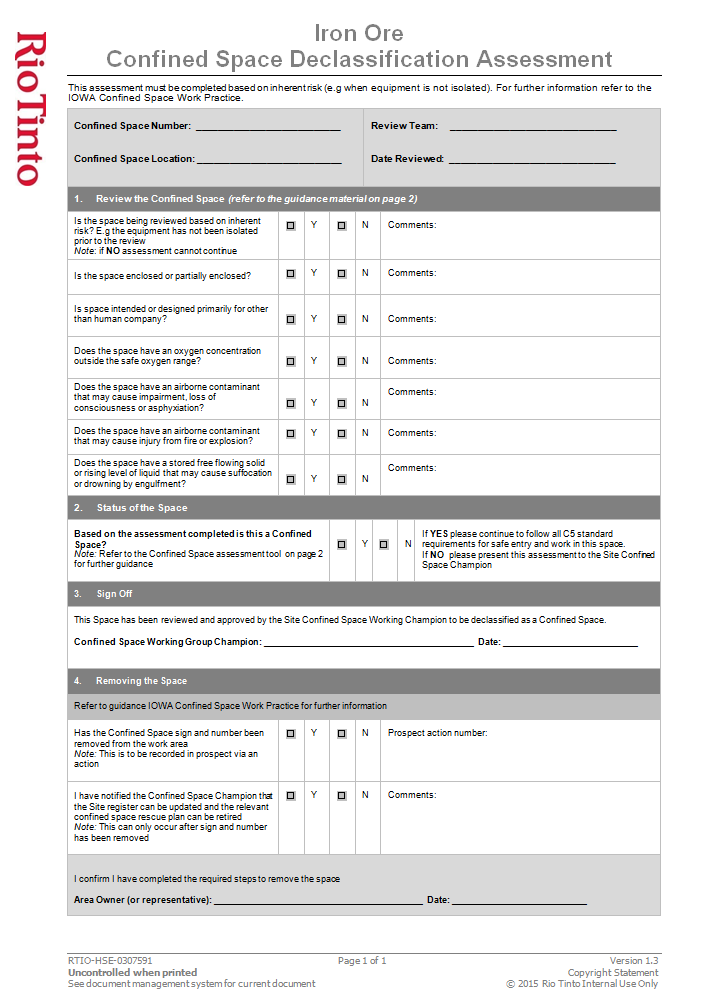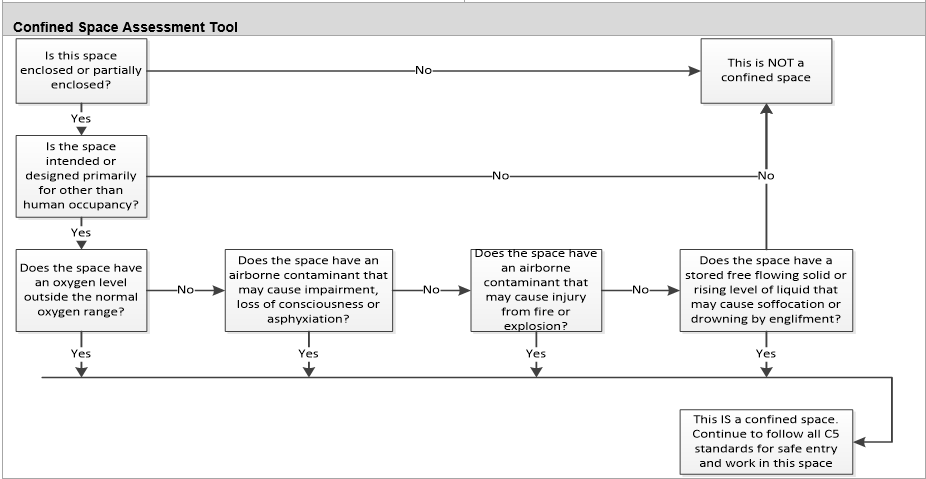Title Page
-
Site conducted
-
Confined Space Location
-
Conducted on
-
Prepared by
-
Other reviewers (Optional)
Assessment
-
This audit should be aligned to the work order - if there are 10 confined spaces to verify on the work order, this audit should contain all 10 confined spaces
Confined Space Audit - add one for each confined space on the work order
-
Enter Confined Space location as per Work Order:
-
Enter Confined Space ID as per Work Order:
-
Is the space being reviewed based on inherent risk? E.g the equipment has not been isolated prior to the review <br>Note: if NO assessment cannot continue
-
This assessment must only be conducted based on inherent risk. If this can not be done seek advice from C5 Champion or HS department.
-
Is the space enclosed or partially enclosed?
-
This is not a confined space. Continue to Section 2. Comments
-
Enclosed or partially enclosed spaces that may meet the definition criteria for a confined space are-
A. Storage tanks, tank cars, process vessels, boilers, pressure vessels, silos, and other tank like compartments.
B. Pipes, sewers, shafts, degreaser and sullage pits, ducts, and similar structures; and
C. Any shipboard spaces entered through a small hatchway or entry point, cargo tanks, cellular double bottom tanks, duct keels, ballast and oil tanks, and void spaces.
With the information provided, if possible select a response for this question. -
Comments
-
Is the space intended or designed primarily for other than human occupancy?
-
This is NOT classified as a confined space - Progress to section 2 to complete audit
-
If this space is not designed for a person to inhabit under operating conditions please answer YES Most enclosed or partially enclosed spaces are intended or designed as primary for human occupancy, e.g. offices and workshops where adequate ventilation and lighting, safe means of access and egress, etc are provided. From time to time they may have atmospheric hazards produced by task related such as welding. Such tasks are not covered by this standard, and other safety systems apply.
-
undefined
-
Q1.A Does the space have an oxygen concentration outside the safe oxygen range?
-
This is classified as a confined space - Progress to section 2 to complete audit
-
E.g Is it reasonable to assume that in its current state - The safe oxygen range is not 19.5-23.5% O2 .
Please respond Yes or No -
undefined
-
Q1. B Does the space have an airborne contaminant that may cause impairment, loss of consciousness or asphyxiation?
-
Some enclosed or partially enclosed spaces have atmospheric contaminants that are harmful to persons but are designed for persons to occupy, e.g. abrasive blasting or spray painting booths. Enclosed or partially enclosed spaces that are intended or designated primarily for human occupation and have systems such as gaseous fire extinguishing systems ( see AS 4214) or inert gas systems for beverage dispensing ( see AS 5034) installed, are not confined spaces. In such cases, other safety systems such as relevant legislation, Standards or codes of practice apply.
Please respond Yes or No -
This is classified as a confined space - Progress to section 2 to complete audit
-
undefined
-
Q1. C Does the space have an airborne contaminant that may cause injury from fire or explosion?
-
This is classified as a confined space - Progress to section 2 to complete audit
-
Comments
-
Q1 . D Does the space have a stored free flowing solid or rising level of liquid that may cause suffocation or drowning by engulfment?
-
A rising level of liquid in an enclosed or partially enclosed space may cause engulfment through the inability of a person to readily exit the space. Drowning in a reservoir, dam or tanks where the level of liquid is static is not considered to be drowning from engulfment.
Please respond Yes or No -
This is classified as a confined space - Progress to section 2 to complete audit
-
Comments
-
Based on the assessment completed; is this a Confined Space?<br><br>Note: If the answered was YES to any of the questions 1. A .B .C .D then this is a confined space. Refer to the Confined Space assessment tool below for further guidance
-
If NO please notify the site C5 confined space champion to authorise declassification and complete hard copy document.
-
-
Is the confined space hazard sign along with the unique identification number present at all possible entry points?
-
Please add photo and details of required signage or label that is missing requires replacment
-
Will the confined space label be replaced before the end of your shift ?
-
Please exit the audit, replace the missing sign and or label and resume once photo evidence can be uploaded in the tab below.
-
Please add photo of new signage and ID label
-
Click on this tab and add an action for the replacement of the sign and or ID label. Please ensure the unique ID number and space description is listed on the notification. All actions shall be completed before the end of the current rotation. <br><br> Has this been completed ?
-
Please add photo of signage
-
Please continue to follow all C5 standard requirements for safe entry and work in this space.
-
Flow chart to assess confined space classification
















